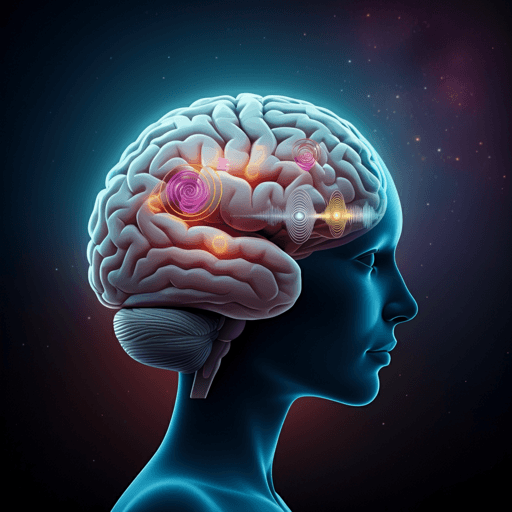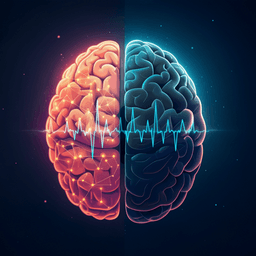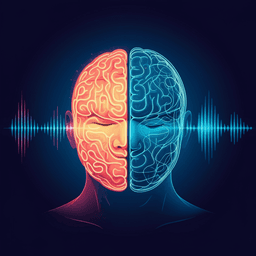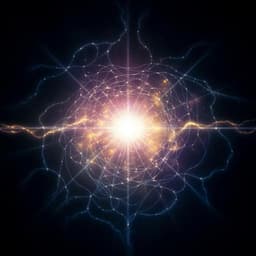
Medicine and Health
Motor learning promotes regionally-specific spindle-slow wave coupled cerebral memory reactivation
D. Baena, E. Gabitov, et al.
Sleep drives precise memory replay: this study shows that slow wave–spindle (SW‑SP) coupling time‑locks motor memory reactivations specifically to the hemisphere involved in learning, while uncoupled spindles recruit primary sensory areas and may support sleep maintenance. This research was conducted by Daniel Baena, Ella Gabitov, Laura B. Ray, Julien Doyon, and Stuart M. Fogel.
~3 min • Beginner • English
Introduction
The study addresses how coupling between slow waves and sleep spindles (SW-SP) supports sleep-dependent memory consolidation through physiological reactivation of brain regions engaged during learning. Prior work shows learning-dependent increases in spindle activity after motor skill learning and correlations between spindle features and behavioral improvements, as well as task-relevant brain activation during sleep. Using simultaneous EEG-fMRI, the authors aim to determine whether motor skill learning induces regionally specific reactivation time-locked to SW-SP complexes, particularly within the striato-cerebello-cortical network (striatum, hippocampus, parietal cortex, cerebellum, motor cortex, thalamus). They hypothesize stronger reactivations in the hemisphere contralateral to the trained (left) hand and seek to dissociate functions of coupled versus uncoupled spindles.
Literature Review
Prior EEG-fMRI studies have linked sleep spindles and slow waves to systems-level changes in brain activity during NREM sleep, implicating thalamus, temporal lobe, cingulate, motor cortex, putamen, and hippocampus. Spindles increase after motor skill learning and predict performance gains and neural changes in motor-related networks. Nishida and Walker reported regionally specific spindle increases over trained motor cortex after unimanual learning. SW-SP coupling has been associated with memory consolidation and neural plasticity across ages, with recent findings indicating dissociable brain activation patterns between coupled spindles, uncoupled spindles, and uncoupled slow waves, and coupling-dependent relationships with cognitive abilities (e.g., fluid intelligence). Hippocampal responses appear stronger during SW-SP complexes than isolated spindles, and putamen shows sleep-dependent reorganization during consolidation. However, the specific role of SW-SP coupling in motor skill memory reactivation and its hemispheric specificity required clarification.
Methodology
Participants: Right-handed adults with normal sleep schedules, BMI 18.5–25, no psychiatric/neurological disorders, non-smokers, limited caffeine/alcohol use, no shift work or medications affecting sleep, minimal formal training as typist/musician (<1 year), not avid gamers. Screening included Beck Depression and Anxiety Inventories (≤8), Epworth Sleepiness Scale (≤9), PSQI (<5), Horne-Ostberg chronotype, Sleep Disorders Questionnaire, actigraphy, and sleep logs. All completed a mock scanner acclimatization night; inclusion required ≥5 min consolidated NREM sleep during a 2-h period.
Datasets: Dataset 1 (N=12) included both motor sequence learning (MSL) and control (CTRL) nights in a within-subjects, counterbalanced design one week apart; training at ~22:30, post-training EEG-fMRI sleep (~2.25 h inside scanner), retest at 09:00. Dataset 2 (N=19) included only MSL with a single-block retest 24 h later. Where appropriate, datasets were merged (combined N=31).
Tasks: MSL used a 5-item explicit finger-tapping sequence (4-1-3-2-4) with the non-dominant (left) hand on an MR-compatible 4-button pad. Training and retest comprised 14 blocks (each: 60 key presses, 12 sequence repetitions), self-paced, high accuracy (~≥83%). Performance metric: inter-keypress interval (IKI). Offline gains assessed by comparing mean IKI in last 4 training blocks vs first 4 retest blocks (Dataset 1) or last 4 training vs single retest block (Dataset 2). CTRL task: simultaneous four-button presses at ~3 Hz (±0.25 Hz), matching motor execution without sequence learning; same structure and performance metric (inter-response interval).
EEG acquisition and preprocessing: 64-channel MR-compatible EEG (Brainamp MR Plus), FCz reference, 5000 Hz sampling; additional ECG channels (Brainamp ExG MR); subject positioned 40 mm off isocenter to reduce BCG artifacts. Analog filters: 0.0159 Hz high-pass (10 s time constant), 500 Hz low-pass. Gradient artifact removed by adaptive average template subtraction; downsampled to 250 Hz. ECG r-peaks identified and corrected; BCG artifacts removed by adaptive template subtraction; residual artifacts addressed via ICA. Re-referenced to averaged mastoids; 60 Hz low-pass applied. Sleep stages scored per AASM guidelines using Counting Sheep PSG toolbox.
Event detection: Slow waves detected at Fz, Cz, Pz, C3, C4 during artifact-free NREM2/SWS using period-amplitude analysis (band-pass 0.46–2.15 Hz Chebyshev filters; peaks >75 µV; duration >0.25 s; negative peak latency extracted). Spindles detected at the same channels using complex demodulation centered at 13.5 Hz (bandwidth 5 Hz; 11–16 Hz), with individualized 99th percentile amplitude threshold; events visually verified; onset and peak latencies extracted.
SW-SP coupling: Spindles labeled as coupled if spindle peak occurred within a 4-s window centered on the slow wave negative peak (covering one 0.5 Hz cycle). Pz prioritized (fast spindles maximal; linked to consolidation). C3 and C4 used for hemispheric analyses. Lag measured between slow wave negative peak and spindle peak. Coupling strength quantified via mean vector length (MVL). Phase at spindle onset computed from bandpass-filtered slow wave; preferred phase per participant via CircStat; uniformity tested by Rayleigh and V-tests.
fMRI acquisition: 3.0 T Siemens TIM TRIO, 12-channel head coil; T2* EPI (40 axial slices, TR=2160 ms, TE=30 ms, FA=90°, FoV 220×220×132 mm, matrix 64×64×43, voxel 3.44×3.44×3.0 mm, GRAPPA=2, 10% gap); structural T1 MPRAGE (1 mm isotropic).
fMRI preprocessing and analysis: SPM12 with DARTEL segmentation; realignment, coregistration, normalization to MNI space, resampling to 3 mm³, 6 mm FWHM smoothing. First-level GLMs per participant/night/channel (Pz, C4, C3) modeled coupled/uncoupled slow waves (aligned to negative peaks) and coupled/uncoupled spindles (aligned to onsets) as stick functions convolved with HRF; motion regressors, 5 CSF CompCor components, 128 s high-pass filter, AR(1)+white noise ReML. Linear contrasts generated t-maps for event types and comparisons. Second-level random-effects one-sample t-tests and repeated-measures ANOVA assessed differences across participants and nights. Voxel-level p<0.005 (two-sided), cluster-extent FWE controlled; small volume corrections in predefined ROIs; anatomical labels via AAL; parameter estimates from sphered ROIs using MarsBar; further stats via statsmodels. Visualization with Nilearn.
Key Findings
Behavior: In Dataset 1 (N=12), performance improved across training blocks (one-way repeated measures ANOVA: F(13,143)=6.48, p<0.001). Early improvements were significant between blocks 1–2 (t(11)=2.667, p=0.022) and 2–3 (t(11)=2.853, p=0.016). Offline gains: MSL showed significant improvement from training to retest (t(11)=2.91, p=0.014), whereas CTRL did not (t(11)=-1.31, p=0.214). CTRL inter-response interval averaged 0.30 ms (SEM=0.01) at end of training and 0.31 ms (SEM=0.001) at retest; block-wise performance remained flat.
Coupling metrics: Across the combined dataset (N=31), participants had on average 366 coupled spindles (SEM=56) and 893 uncoupled spindles (SEM=95). Preferred SW-SP coupling phase occurred shortly before the down-to-up state peak (0°) in 26/31 participants (V-test p<0.001). Rayleigh tests indicated non-uniform phase distributions in 26/31 participants (p<0.05), with spindles adjacent to or immediately following the positive slow wave peak.
EEG-fMRI activations: Coupled SW-SP complexes (Pz) elicited widespread activation in motor cortical regions (primary motor cortex, premotor cortex, SMA), overlapping with regions engaged during MSL training (reactivation). Increased BOLD in primary motor cortex was lateralized to the trained (right) hemisphere; additional increases in right thalamus and bilateral medial temporal lobe. No regions showed stronger activation for uncoupled slow waves relative to coupled SW-SP.
Uncoupled spindles: Isolated spindles preferentially recruited primary sensory regions—somatosensory cortex, primary auditory cortex, and primary visual cortex—compared to SW-SP complexes.
Task specificity: In participants with both nights (Dataset 1), post-MSL sleep showed greater activation (coupled SW-SP) than post-CTRL in bilateral thalamus, right parahippocampus, superior anterior cerebellum (lobules 4/5), with clusters extending into occipital and medial parietal lobes (calcarine, occipital superior, cuneus, precuneus), and bilateral medial superior parietal and prefrontal cortex. No regions had stronger coupled SW-SP responses after CTRL versus MSL. Uncoupled slow waves showed no learning-related differences.
Hemispheric lateralization: At C4 (contralateral to trained left hand), coupled SW-SP complexes during post-MSL sleep exhibited stronger, regionally specific increases in and around the precentral/postcentral hand knob, with additional bilateral thalamus and cerebellar, occipital, and parietal clusters; no decreases observed. At C3 (ipsilateral), only the medial parietal lobe (precuneus) increased; task-related network showed decreases in precentral gyrus and insular cortex, suggesting ipsilateral inhibition.
Overall: Results support regionally and hemispherically specific reactivation time-locked to SW-SP coupling after motor learning, and a double dissociation in which uncoupled spindles recruit sensory cortices, consistent with a role in sleep maintenance.
Discussion
Findings demonstrate that motor learning enhances regionally specific cerebral reactivation during sleep, time-locked to SW-SP coupling. Activations in motor cortical areas (including the hand knob), thalamus, hippocampal/parahippocampal regions, and cerebellum align with networks supporting motor sequence learning and correlate with the trained hemisphere, supporting targeted consolidation through reactivation. The dissociation shows uncoupled spindles recruit primary sensory cortices, consistent with their proposed role in sleep protection and maintenance, whereas coupled SW-SP events support memory consolidation. Results extend prior observations by showing hemispheric lateralization of reactivation with contralateral increases and ipsilateral decreases/inhibition, and suggest that SW-SP coupling underlies hippocampal-neocortical dialogue in consolidating motor memory. Putamen activation during training and adjacent reactivation during coupled events is consistent with a shift from associative to sensorimotor representations during consolidation. Although behavioral-brain correlations were not significant (likely underpowered), contrasts between post-MSL and post-CTRL nights indicate specificity of coupled SW-SP activations to learning.
Conclusion
SW-SP coupling is a key electrophysiological marker of regionally and hemispherically specific offline reactivation supporting motor sequence memory consolidation during sleep. Coupled spindles preferentially engage task-relevant motor and memory networks, distinct from uncoupled spindles that recruit sensory areas likely involved in sleep maintenance. The study provides evidence for precise, contralateral motor cortex reactivation (hand area) after unimanual learning and implicates hippocampal and thalamocortical systems in consolidation. Future work should increase sample sizes, assess event subtypes (fast vs slow spindles; NREM2 vs SWS), directly test sleep maintenance mechanisms for uncoupled spindles, and examine longitudinal changes to confirm mechanistic roles of SW-SP complexes in the transformation of motor memory traces.
Limitations
- Limited sleep duration inherent to EEG-fMRI reduced the number of events, preventing subdivision into fast vs slow spindles and NREM2 vs SWS categories.
- Possible presence of K-complexes accompanying slow oscillations during N2 cannot be ruled out.
- Binning spindles into coupled vs uncoupled reduced statistical power; merging two datasets mitigated this but was not feasible for all analyses.
- Putamen cluster related to SW-SP coupling was below the conservative cluster-size cutoff (k=30), though included based on strong a priori justification.
- Behavioral-brain correlation analyses were not significant, likely due to limited participant numbers (especially Dataset 2) and insufficient retest measures in the combined dataset.
- Generalization is constrained by modest sample sizes and the specific unimanual motor sequence paradigm.
Related Publications
Explore these studies to deepen your understanding of the subject.







